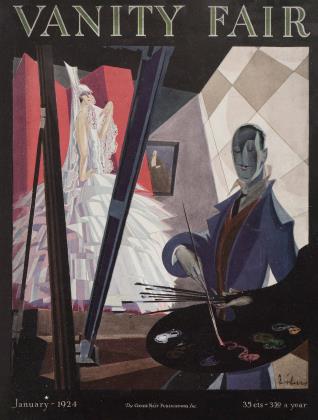Sign In to Your Account
Subscribers have complete access to the archive.
Sign In Not a Subscriber?Join NowAutomotive Thoughts Become Hectic
The Scramble for New Ideas Dominates the National Automobile Shows and Bewilders the Motoring Public
GEORGE W. SUTTON, JR.
WELL, here it is Show Time again, and so much going on in the automobile world that it is almost impossible for a single observer to take note of it all. Every day new and revolutionary mechanical changes are being announced on some of the best known cars in the country. The year just past has witnessed the introduction of more new and semi-new ideas than any year since motoiing began; and those who buy and use the millions of cars poured forth from our gigantic automobile factories, may well be confused.
The present frenzied developments of new automobile ideas will, beyond a doubt, continue for several years. When the miasma disintegrates and the motorist can again get a perspective on the matters which affect his personal transportation, it will be very interesting to see which of the radical changes now being inaugurated in cars of well known makes have survived, and which changes have been discarded as impractical, unnecessary, or too expensive to warrant their retention.
Practically all the new thoughts now being offered the motoring public are directly in the line of progress. Some of them are, unquestionably, good. Others are, just as unquestionably, destined to an early demise, owing to the lack of knowledge on the part of their sponsors of the fundamental character of the American public. In spite of the comparative newness of American civilization, the American public is probably more conservative than any other. This is certainly true of the American motoring public. The Englishman or the Frenchman will not hesitate to appear upon the highways in a car so radical in design as to invite the attention of the passing crowd. The American shrinks from such a course. Hence, the existence in Europe of thousands of automobiles, some of them large but most of them very small, of extremely radical design, contrasted with the use here of 14,000,000 cars almost identical in appearance and coloring.
Our great manufacturers of standard cars understand this psychology pretty well and are making no efforts to force the adoption of cars of unusual design or brilliant color schemes. Some of the importers of foreign cars have tried it during the past few years, but without notable success.
In the matter of chassis construction, however, the intense competition now active in the automobile world is bringing about most unusual and revolutionary developments. During the past year we have seen the introduction and tremendous exploitation of four-wheel brakes, balloon tires and other important innovations, many of which have been imported from Europe. Superchargers are in the offing, and considerable agitation may be ex¾ pected over these and other devices to overcome the present needless inefficiency of our cars in the important matter of miles per gallon of gasolene. It may be, also, that some progress will be made here in the development of streamline bodies but that is doubtful, because the American motorist is apparently well satisfied with the present automobile bodies which art being offered him.
The first session of the National Automobile Show, which opens at the Eighth Coast Artillery Armory in New York or January 5th, will reveal some interesting and important secrets of chassis construction on which a number of the manufacturers of popular cars are now at work. Some of these we know about, but may not reveal. However, a large number of the 1924 cars are now to be seen, and it is possible to divide a substantial part of the automobile industry into three divisions, namely, (1) those companies which have introduced very radical changes in their cars; (2) those which have brought out new models incorporating important but not revolutionary changes; and (3) those which are continuing their 1923 models with only minor refinements.
Continued on page 76
Continued from page 74
In the first class should, by all means, be mentioned Cadillac, Oklsmobile, Oakland, Buick, Studebaker, Locomobile, Packard, DuPont, Cleveland, Cole, Franklin, Star, Chandler, Anderson RickenbackerandMarmon.
In the second class might be placed Haynes, Moon, Reo, Overland, Ford, Kissel, H.C.S., Auburn, Flint, National, Jordan, Nash, Velie and McFarlan.
In the third class would come such cars as Hupmobile, Dodge, Davis, Case, R. &. V. Knight, Jewett, Gardner, Columbia, WillysKnight, Wills Sainte Claire, Dort, Lincoln, Stearns, Durant, Premier and Maxwell.
It is quite possible that many of the units in classes two and three will move into class one by the time this article appears in print.
The cars mentioned in class one embody all the bewildering changes which are now taking place in the American motor world; and some of these innovations are very important from the motorist's standpoint. This is a period of most intense development of new ideas in motoring and it will be interesting to see what further secrets and innovations the manufacturers will bring forth at the shows.
 View Full Issue
View Full Issue












Subscribers have complete access to the archive.
Sign In Not a Subscriber?Join Now